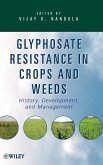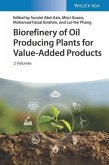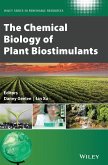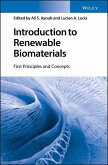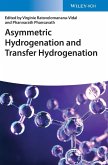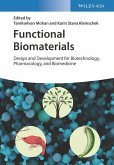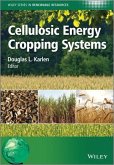Modern Crop Protection Compounds
Volume 2: Fungicides
Herausgegeben:Jeschke, Peter; Lamberth, Clemens; Lorsbach, Beth
Modern Crop Protection Compounds
Volume 2: Fungicides
Herausgegeben:Jeschke, Peter; Lamberth, Clemens; Lorsbach, Beth
- Gebundenes Buch
- Merkliste
- Auf die Merkliste
- Bewerten Bewerten
- Teilen
- Produkt teilen
- Produkterinnerung
- Produkterinnerung
This completely revised and updated fourth edition of the gold-standard reference on crop protection compounds covers in this volume the most important fungicides, their mode of action, and the research that led to their use in agriculture.
Andere Kunden interessierten sich auch für
![Glyphosate Resistance Glyphosate Resistance]() Glyphosate Resistance144,99 €
Glyphosate Resistance144,99 €![Biorefinery of Oil Producing Plants for Value-Added Products Biorefinery of Oil Producing Plants for Value-Added Products]() Biorefinery of Oil Producing Plants for Value-Added Products355,00 €
Biorefinery of Oil Producing Plants for Value-Added Products355,00 €![The Chemical Biology of Plant Biostimulants The Chemical Biology of Plant Biostimulants]() The Chemical Biology of Plant Biostimulants160,99 €
The Chemical Biology of Plant Biostimulants160,99 €![Introduction to Renewable Biomaterials Introduction to Renewable Biomaterials]() Introduction to Renewable Biomaterials89,99 €
Introduction to Renewable Biomaterials89,99 €![Asymmetric Hydrogenation and Transfer Hydrogenation Asymmetric Hydrogenation and Transfer Hydrogenation]() Virginie Ratovelomanana-VidalAsymmetric Hydrogenation and Transfer Hydrogenation137,99 €
Virginie Ratovelomanana-VidalAsymmetric Hydrogenation and Transfer Hydrogenation137,99 €![Functional Biomaterials. 2 volumes Functional Biomaterials. 2 volumes]() Functional Biomaterials. 2 volumes199,00 €
Functional Biomaterials. 2 volumes199,00 €![Cellulosic Energy Cropping Systems Cellulosic Energy Cropping Systems]() Cellulosic Energy Cropping Systems147,99 €
Cellulosic Energy Cropping Systems147,99 €-
-
-
This completely revised and updated fourth edition of the gold-standard reference on crop protection compounds covers in this volume the most important fungicides, their mode of action, and the research that led to their use in agriculture.
Produktdetails
- Produktdetails
- Verlag: Wiley-VCH
- Artikelnr. des Verlages: 1135271 000
- 4. Aufl.
- Seitenzahl: 460
- Erscheinungstermin: 3. September 2025
- Englisch
- Abmessung: 244mm x 170mm
- ISBN-13: 9783527352715
- Artikelnr.: 73325648
- Herstellerkennzeichnung Die Herstellerinformationen sind derzeit nicht verfügbar.
- Verlag: Wiley-VCH
- Artikelnr. des Verlages: 1135271 000
- 4. Aufl.
- Seitenzahl: 460
- Erscheinungstermin: 3. September 2025
- Englisch
- Abmessung: 244mm x 170mm
- ISBN-13: 9783527352715
- Artikelnr.: 73325648
- Herstellerkennzeichnung Die Herstellerinformationen sind derzeit nicht verfügbar.
Peter Jeschke was a senior fellow in research and development in Pest Control Chemistry at Bayer AG Crop Science in Germany, from 1997 until his retirement in 2022.He is also an honorary professor at the Heinrich Heine University Düsseldorf, Germany. He has more than 250 patent applications and publications to his name, and he is an Associate Editor for "Pest Management Science" of the Society of Chemical Industry (UK) and also a member of the Editorial Advisory Board for the "Ullmann's Encyclopedia of Industrial Chemistry" (Wiley-VCH).
Clemens Lamberth retired in 2024 after more than 30 years as a senior principal scientist in the chemical research department of Syngenta Crop Protection AG in Switzerland. He is specialized in the discovery of fungicides and is the inventor of the fungicide mandipropamid. He is the author of ca. 100 peer-reviewed publications and book chapters, 120 patents, and edited the two Wiley-VCH books "Bioactive Heterocyclic Compound Classes" and "Bioactive Carboxylic Compound Classes". In 2018, he received the Senior Industrial Science Award from the Swiss Chemical Society.
Beth Lorsbach is the Global Head of Innovation and Development at Nufarm in Indianapolis, USA. She is responsible for delivering innovative and disruptive solutions to solve farmers' needs as Nufarm pivots to become an agriculture innovator. She also provides technical, personnel, and organizational management of the chemistry functional groups whose focus is to discover and characterize novel active ingredients for commercial development. She has authored over 94 patent applications, 23 external publications, and 31 conference presentations. She received the 2015 Rising Star Award from the American Chemical Society (ACS) and was named a 2019 ACS Fellow.
Clemens Lamberth retired in 2024 after more than 30 years as a senior principal scientist in the chemical research department of Syngenta Crop Protection AG in Switzerland. He is specialized in the discovery of fungicides and is the inventor of the fungicide mandipropamid. He is the author of ca. 100 peer-reviewed publications and book chapters, 120 patents, and edited the two Wiley-VCH books "Bioactive Heterocyclic Compound Classes" and "Bioactive Carboxylic Compound Classes". In 2018, he received the Senior Industrial Science Award from the Swiss Chemical Society.
Beth Lorsbach is the Global Head of Innovation and Development at Nufarm in Indianapolis, USA. She is responsible for delivering innovative and disruptive solutions to solve farmers' needs as Nufarm pivots to become an agriculture innovator. She also provides technical, personnel, and organizational management of the chemistry functional groups whose focus is to discover and characterize novel active ingredients for commercial development. She has authored over 94 patent applications, 23 external publications, and 31 conference presentations. She received the 2015 Rising Star Award from the American Chemical Society (ACS) and was named a 2019 ACS Fellow.
VOLUME II: FUNGICIDES
Overview
19.) FRAC: Mode of Action Classification and Resistance Risk of Fungicides
20.) Fungicides Acting on Oxidative Phosphorylation
21.) Fungicides Acting on Amino Acid and Protein Synthesis: Anilinopyrimidines - Assumed Methionine Biosynthesis Inhibitors
22.) Fungicides Acting on Signal Transduction
23.) Fungicides Acting on Mitosis and Cell Division: Zoxamide, an Antitubulin Fungicide for Control of Oomycete Pathogens
24.) Sterol Biosynthesis Inhibitors
25.) Carboxylic Acid Amide (CAA) Fungicides
26.) Fluopicolide: An Anti-Oomycete Fungicide with a Unique Mode of Action
27.) Melanin Biosynthesis Inhibitors
28.) Modern Powdery Mildew Fungicides
29.) Newest Aspects of Nucleic Acid Synthesis Inhibitors - Metalaxyl-M
30.) Host Defense Inducers
31.) Oxysterol-Binding Protein Inhibitors
32.) Quinofumelin and Other Dihydroorotate Dehydrogenase Inhibitors
33.) Pyridachlometyl and Other Tubulin Dynamics Modulators
34.) Aminopyrifen and Other GPI-Anchored Wall Transfer Protein Inhibitors
35.) Fungicides with Unknown Mode of Action
Overview
19.) FRAC: Mode of Action Classification and Resistance Risk of Fungicides
20.) Fungicides Acting on Oxidative Phosphorylation
21.) Fungicides Acting on Amino Acid and Protein Synthesis: Anilinopyrimidines - Assumed Methionine Biosynthesis Inhibitors
22.) Fungicides Acting on Signal Transduction
23.) Fungicides Acting on Mitosis and Cell Division: Zoxamide, an Antitubulin Fungicide for Control of Oomycete Pathogens
24.) Sterol Biosynthesis Inhibitors
25.) Carboxylic Acid Amide (CAA) Fungicides
26.) Fluopicolide: An Anti-Oomycete Fungicide with a Unique Mode of Action
27.) Melanin Biosynthesis Inhibitors
28.) Modern Powdery Mildew Fungicides
29.) Newest Aspects of Nucleic Acid Synthesis Inhibitors - Metalaxyl-M
30.) Host Defense Inducers
31.) Oxysterol-Binding Protein Inhibitors
32.) Quinofumelin and Other Dihydroorotate Dehydrogenase Inhibitors
33.) Pyridachlometyl and Other Tubulin Dynamics Modulators
34.) Aminopyrifen and Other GPI-Anchored Wall Transfer Protein Inhibitors
35.) Fungicides with Unknown Mode of Action
VOLUME II: FUNGICIDES
Overview
19.) FRAC: Mode of Action Classification and Resistance Risk of Fungicides
20.) Fungicides Acting on Oxidative Phosphorylation
21.) Fungicides Acting on Amino Acid and Protein Synthesis: Anilinopyrimidines - Assumed Methionine Biosynthesis Inhibitors
22.) Fungicides Acting on Signal Transduction
23.) Fungicides Acting on Mitosis and Cell Division: Zoxamide, an Antitubulin Fungicide for Control of Oomycete Pathogens
24.) Sterol Biosynthesis Inhibitors
25.) Carboxylic Acid Amide (CAA) Fungicides
26.) Fluopicolide: An Anti-Oomycete Fungicide with a Unique Mode of Action
27.) Melanin Biosynthesis Inhibitors
28.) Modern Powdery Mildew Fungicides
29.) Newest Aspects of Nucleic Acid Synthesis Inhibitors - Metalaxyl-M
30.) Host Defense Inducers
31.) Oxysterol-Binding Protein Inhibitors
32.) Quinofumelin and Other Dihydroorotate Dehydrogenase Inhibitors
33.) Pyridachlometyl and Other Tubulin Dynamics Modulators
34.) Aminopyrifen and Other GPI-Anchored Wall Transfer Protein Inhibitors
35.) Fungicides with Unknown Mode of Action
Overview
19.) FRAC: Mode of Action Classification and Resistance Risk of Fungicides
20.) Fungicides Acting on Oxidative Phosphorylation
21.) Fungicides Acting on Amino Acid and Protein Synthesis: Anilinopyrimidines - Assumed Methionine Biosynthesis Inhibitors
22.) Fungicides Acting on Signal Transduction
23.) Fungicides Acting on Mitosis and Cell Division: Zoxamide, an Antitubulin Fungicide for Control of Oomycete Pathogens
24.) Sterol Biosynthesis Inhibitors
25.) Carboxylic Acid Amide (CAA) Fungicides
26.) Fluopicolide: An Anti-Oomycete Fungicide with a Unique Mode of Action
27.) Melanin Biosynthesis Inhibitors
28.) Modern Powdery Mildew Fungicides
29.) Newest Aspects of Nucleic Acid Synthesis Inhibitors - Metalaxyl-M
30.) Host Defense Inducers
31.) Oxysterol-Binding Protein Inhibitors
32.) Quinofumelin and Other Dihydroorotate Dehydrogenase Inhibitors
33.) Pyridachlometyl and Other Tubulin Dynamics Modulators
34.) Aminopyrifen and Other GPI-Anchored Wall Transfer Protein Inhibitors
35.) Fungicides with Unknown Mode of Action


